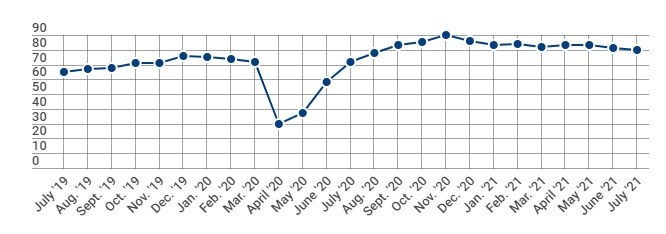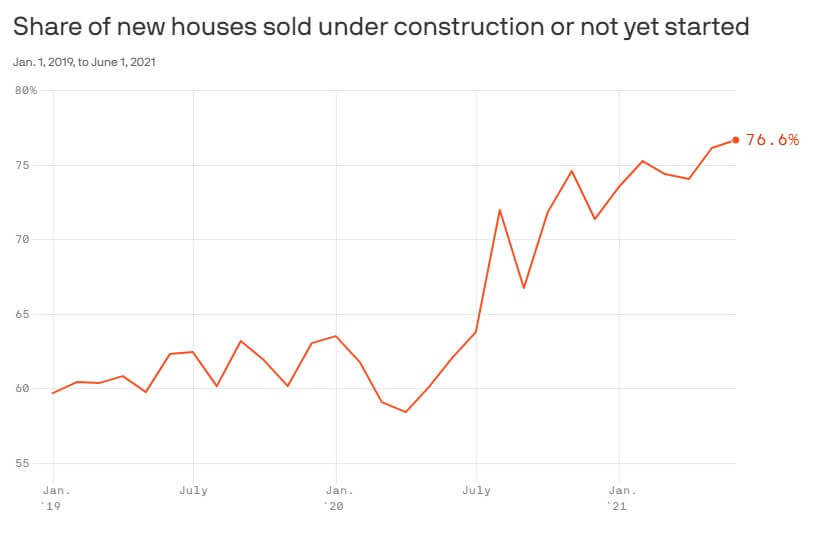Martha C. White of CNBC opened up the week by reporting on the increasing hedge fund interest in single-family home assets. “Competition from investment entities is a symptom of a much bigger problem in the housing market…The reason why we have this supply crisis right now goes well beyond investors. We just haven’t produced enough housing in the past 10 years.”
Jerusalem Demsas of Vox reported earlier this month that institutional investors are not to blame for the lack of supply or rising housing prices. In fact, overall properties owned for investment purposes has dropped.

Source: Vox
“The role of institutional investors is still being studied, but the popularity of the narrative strikes at something dangerous: People want a convenient boogeyman and when they get it, they often ignore the structural problems that are harder to combat. Housing undersupply is the result of decades of locals opposing new home building. It’s not something that can be blamed on Wall Street greed and the nefarious tinkering of a private equity firm. And that’s a much harder truth to stomach.”
According to Real Trends, purchases by institutional investors jumped 2.7% in Q1 2021, but only 15 million single-family rental homes (2% of the overall market) in the U.S. are owned by these players.
Carol Ryan in the Wall Street Journal (subscription required) summed up the ongoing discussion around the role of hedge funds in real estate as follows, “It’s unclear how many family homes the financial giants can snap up before there is a public backlash. Institutional investors already own 55% of the U.S. supply of multifamily homes, typically condos. However, they are minnows in the most appealing part of the housing market.”
Finally, couple this with Derek Thompson’s Atlantic piece titled BlackRock Is Not Ruining the U.S. Housing Market, wherein the author summarizes that “the real villain isn’t a faceless Wall Street Goliath; it’s your neighbors and local governments stopping the construction of new units.”
Homebuilder update
Supply is indeed a serious issue, and homebuilders are feeling the pain most. According to Axios, some builders are actually turning down new home sale orders to keep their production pipeline manageable. “Builders are contending with shortages of building materials, buildable lots and skilled labor as well as a challenging regulatory environment.”
According to the National Association of Home Builders (NAHB), strong demand has offset supply shortages for builders as confidence edged one point higher this month to sit at 80 on the National Association of Home Builders (NAHB)/Wells Fargo Housing Market Index (HMI).

Source: NAHB
“Builders continue to grapple with elevated building material prices and supply shortages, particularly the price of oriented strand board, which has skyrocketed more than 500 percent above its January 2020 level,” said NAHB Chairman Chuck Fowke.
In a boost for builders, Sam Ro of Axios reports that homeowners are so eager to purchase homes that more than ever they are closing on new homes “that aren’t even close to move-in ready.”

Source: Axios
What is a countercyclical capital buffer
Chris Matthews of MarketWatch commented this week on tools the federal government had at its disposal to cool the red-hot housing market. One such tool, which the Federal Reserve hasn’t invoked yet, is the countercyclical capital buffer. “This rule allows the Fed to require banks to fund themselves with greater amounts of equity in the form of retained earnings or money raised from stockholders and less from debt.”
In other words, the Fed would require banks to raise their capital reserves during boom times (i.e. now), which would help break runaway asset prices as banks are forced to tighten their lending to meet the new requirements.
According to IFR this week, “Bank regulators are being urged to look again at the use of “buffers” as part of the global capital framework, as evidence mounts that banks did not use their cushions during the Covid-19 crisis and there is a stigma attached to doing so.”
This actually happened in England, according to Retuers, where the Bank of England allowed banks to tap countercyclical capital buffers, “but lenders were reluctant to do so, worried about adverse market and credit rating reactions.”





